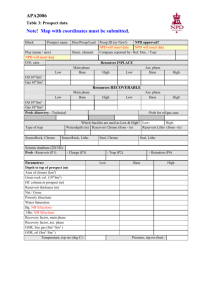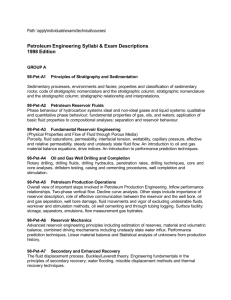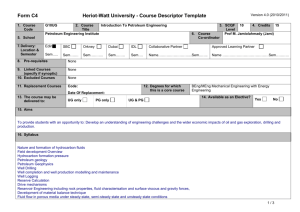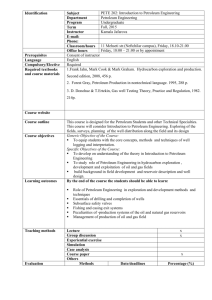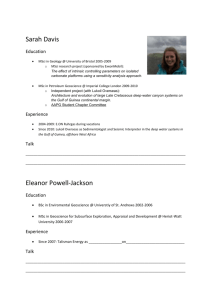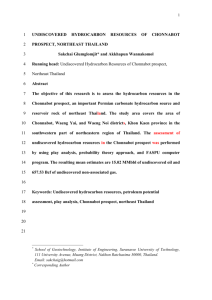QUANTITATIVE PETROLEUM EVALUATION
advertisement
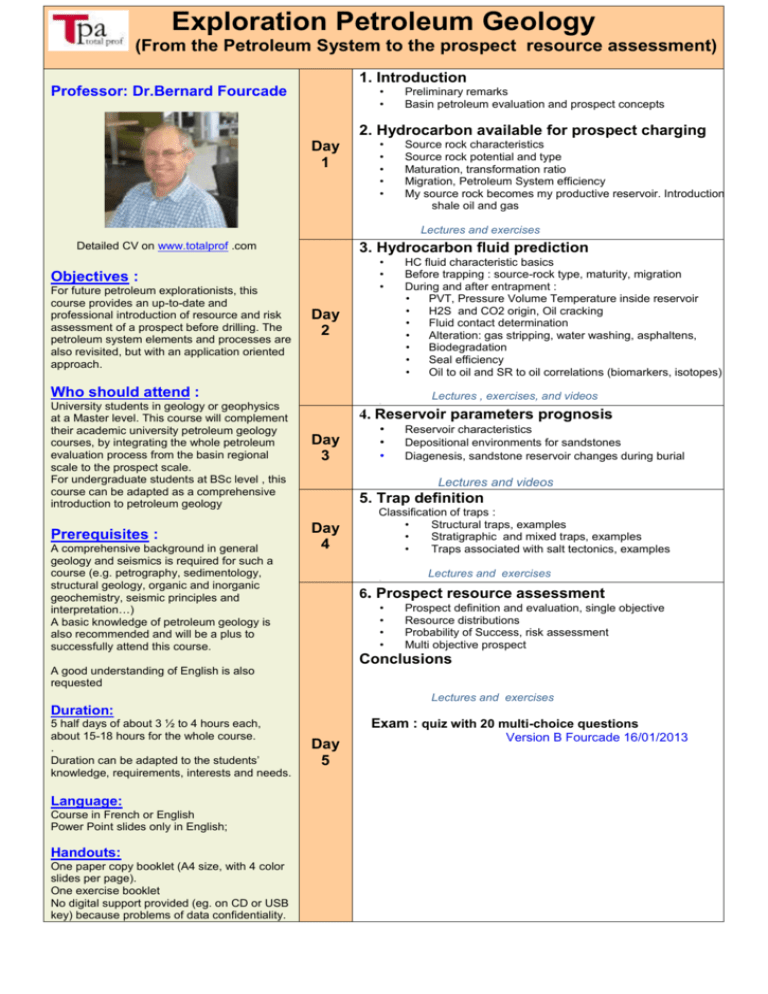
Exploration Petroleum Geology (From the Petroleum System to the prospect resource assessment) 1. Introduction Professor: Dr.Bernard Fourcade • • Preliminary remarks Basin petroleum evaluation and prospect concepts 2. Hydrocarbon available for prospect charging Day 1 • • • • • Source rock characteristics Source rock potential and type Maturation, transformation ratio Migration, Petroleum System efficiency My source rock becomes my productive reservoir. Introduction to shale oil and gas Lectures and exercises Detailed CV on www.totalprof .com 3. Hydrocarbon fluid prediction • • • Objectives : For future petroleum explorationists, this course provides an up-to-date and professional introduction of resource and risk assessment of a prospect before drilling. The petroleum system elements and processes are also revisited, but with an application oriented approach. Day 2 Who should attend : University students in geology or geophysics at a Master level. This course will complement their academic university petroleum geology courses, by integrating the whole petroleum evaluation process from the basin regional scale to the prospect scale. For undergraduate students at BSc level , this course can be adapted as a comprehensive introduction to petroleum geology Prerequisites : A comprehensive background in general geology and seismics is required for such a course (e.g. petrography, sedimentology, structural geology, organic and inorganic geochemistry, seismic principles and interpretation…) A basic knowledge of petroleum geology is also recommended and will be a plus to successfully attend this course. HC fluid characteristic basics Before trapping : source-rock type, maturity, migration During and after entrapment : • PVT, Pressure Volume Temperature inside reservoir • H2S and CO2 origin, Oil cracking • Fluid contact determination • Alteration: gas stripping, water washing, asphaltens, • Biodegradation • Seal efficiency • Oil to oil and SR to oil correlations (biomarkers, isotopes) Lectures , exercises, and videos • 4. Reservoir parameters prognosis Day 3 • • • Reservoir characteristics Depositional environments for sandstones Diagenesis, sandstone reservoir changes during burial Lectures and videos 5. Trap definition Day 4 Classification of traps : • Structural traps, examples • Stratigraphic and mixed traps, examples • Traps associated with salt tectonics, examples Lectures and exercises • 6. Prospect resource assessment • • • • Prospect definition and evaluation, single objective Resource distributions Probability of Success, risk assessment Multi objective prospect Conclusions A good understanding of English is also requested Lectures and exercises Duration: 5 half days of about 3 ½ to 4 hours each, about 15-18 hours for the whole course. . Duration can be adapted to the students’ knowledge, requirements, interests and needs. Language: Course in French or English Power Point slides only in English; Handouts: One paper copy booklet (A4 size, with 4 color slides per page). One exercise booklet No digital support provided (eg. on CD or USB key) because problems of data confidentiality. Exam : quiz with 20 multi-choice questions Day 5 Version B Fourcade 16/01/2013 Exploration Petroleum Geology Lomonosov Moscow State University, Moscow, Russia, March 25th – 29th 2013 From the petroleum system to the prospect resource assessment Course detailed programme by Dr. Bernard Fourcade, from the Total Professor Association Day 1: Monday , March 25th, 2013 1 - Introduction - 100. Course content, requirements , preliminary remarks 110. Basin petroleum and prospect evaluation concepts and methodology 2 – Hydrocarbon available for prospect charging 200. Source rocks (=SR) o (201) SR characteristics, (202) SR parameters (=Petroleum potential), (203) SR types, (204) SR transformation ratio, (205) SR during geological times. - 210. Maturation o (211) Optical and (212) chemical techniques for maturity evaluation, (213) oil and gas windows, (214) transformation ratio. - 220. Hydrocarbon migration o Drainage areas, migrations routes, richness and efficiency of the petroleum systems, examples Exercice n° 1: define the HC migration pathways on a geological cross section 10’ - 230. My source rock is now my reservoir: o Introduction to shale gas. A worldwide game changer ? Video Mauritania - Day 2 : Tuesday , March 26th, 2013 3 - Hydrocarbon fluid prediction - - 300. HC before entrapment o Fluid characteristics according to source rock types, maturity .. 310. HC fluids inside the reservoir o Fluid characteristics at reservoir conditions, PVT, classification Exercice n°2: determine the fluid characteristics of a prospect by calibration from a nearby field using thermodynamic phase diagram 15’ 320. Non hydrocarbon fluids o H2S, CO2, origin and risks Video: CO2 capture and sequestration at Lacq pilot plant , France - 330. Oil cracking o Thermal changes of oil inside a reservoir - 340. Fluid contact determination o Oil/water, Gas/oil or Gas/water contact determination for prospect or fields, from seismics, logs, pressure gradients, RFT/MDT/DST, Exercice n°3 : fluid contact determination from a RFT plot 15’ - - - 350. Oil to oil and source rock correlations o Organic geochemistry techniques, gas chromatography, molecular geochemistry, mass spectrometry, biomarkers, stable isotopes; application examples 360. HC Fluid alteration inside the reservoir o Biodegradation, water washing, gas stripping, asphalten precipitation. Impact on the oil characteristics 370. Top Seal efficiency optional o Top and fault seal evaluation Day 3 : Wednesday , March 27th, 2013 4 - Reservoir parameters prognosis - 400. Reservoir general characteristics o Reservoir definition, parameters controlling porosity, permeability, - 410. Sandstone reservoir depositional environments o Eolian, fluvial, deltaic, deep marine deposits, turbidites. Reservoir geometries, oil field examples. Video Akpo, deep offshore Nigeria - 420. Diagenesis of sandstone reservoirs (Optional depending of timing) o Porosity reduction by mechanical compaction, chemical compaction, Quartz cementation, clay coating, cement dissolution; impact on reservoir properties, examples Day 4 : Thursday , March 28th, 2013 5 - Trap definition and classification - 500. Structural traps o Fold and fault associated traps, in different tectonic settings, field examples Video Sismage - 510. Stratigraphic and mixed traps o Classification, conformable, unconformity related traps, mixed structural and stratigraphic traps, examples Exercice n°4: imagine potential traps from a seismic section 20’ - 520. Salt tectonics o Salt structure nomenclature, examples of traps associated with salt Day 5 : Friday, March 29th, 2013 Conclusions : to choose among 4 options: 6 - Prospect resource assessment - 600. Prospect definition: single objective o Required data, procedure and techniques used for prospect evaluation - 610. Prospect resource distributions o How to build reserve/resource distribution for a prospect Exercices n°5: Structural closure of a prospect, Mini, Mode and Maxi closures 0.5 hour 620. Risk assessment o Risk evaluation and Prospect Probability of Success 630. Multi-objective prospects Exercice n°6: define 1P, 2P, 3P reserves from a map and a cross section over a drilled prospect 0.5 hour - 7- The Exploration & Production process The different phases of the Exploration and Production process: from preliminaries studies in exploration to the field abandonment at the end of production, through the basin evaluation, petroleum system definition, prospect assessment, exploration drilling, field appraisal, development and production. Short review of the geosciences techniques used during the different phases of the E & P process: introduction to: satellite remote sensing, field geology, seismics, structural geology, sedimentology, well logging, testing, petrophysics, reservoir modeling and management. The different jobs in petroleum geosciences : description of the different jobs and their specialities: geologists (well site geologist, field geologist, specialists, etc…), geophysicists (seismic acquisition, processing , interpretation, special techniques), reservoir engineers (petrophysicists, log analysts, reservoir modeling, etc..). - - - - 8 - Examples of present day exploration challenges: - Back to the old days of surface geology exploration. A new petroleum province in the making: the Zagros in Kurdistan, Iraq The Artic challenges Application of the plate tectonic concept: exploration cruise across the South Atlantic Ocean : from the pre-salt Tupi/Ulla discoveries in Brazil to the Kwanza basin in Angola and from Jubilee in Ghana to Zaedius in French Guyana Exam : Quiz with 20 multi-choice questions Course evaluation by the students
